What is the perfect length for your SaaS trial? Where, exactly, is the sweet spot between customers learning to love your product and people taking advantage of your generosity? Does that sweet spot even exist?
To help you answer these tricky questions, we’re going to take a dive into SaaS free trial data. We’ll explore everything you need to know about SaaS free trials, from the basics of what they are to what the data says about their advantages, their uses, and their optimum length.
What is a SaaS free trial?
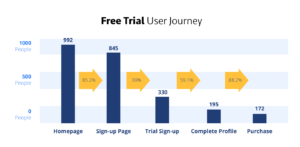
A free trial is exactly what it sounds like. An opportunity for customers to trial your software for free. A free trial acts as a ‘lead magnet’, an offering which draws in customers. Everybody likes getting something for nothing, and people are often wary of downloadable software.
By offering a free trial, you can both leverage people’s love of a bargain and show customers that your product is trustworthy, well-made, and (hopefully!) useful. The idea is mostly that customers love your product so much that they subscribe, and that subscription money starts rolling in. But, as we’ll see, there is a bit more to it than that.
Let’s take a look:
What are the benefits of a free SaaS trial?
The ultimate aim with a free trial is that your customer finds the software so invaluable that they can’t bear to part with it once the trial is up. However, even if customers don’t subscribe at the end of the trial, the process isn’t completely wasted. If done right, your SaaS free trial will also have the following advantages:
- Bringing people to your website.
- Raising brand awareness.
- Helping to build your following.
- Data gathering.
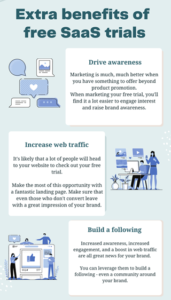
Image created by author
Free trials are particularly useful as a marketing hook. Let’s say, for example, that you are trying to promote your business phone line package. Promotional content which simply praises your telecoms package and exhorts customers to buy, is much less engaging than promotional content which offers those customers something for free.
Mentioning free trials in things like subject lines and CTAs is a fantastic way to boost engagement. Even customers that don’t convert are more likely to engage with your content. They may sign up for your newsletter, or follow your social media.
All of this builds your web presence, which will ultimately boost your brand’s reputation, especially if you make the most of things like landing pages.
What’s more, it helps you to gather customer data. Data helps you to learn about your customers, which will help you to give those customers what they want.
But what about the bottom line? Boosting engagement and awareness is all very well, but do free trials actually increase your sales?
Do free trials increase sales?
The short answer to this question is ‘Yes. Sort of’. In general, the number of new customers SaaS companies gain from free trials has dropped over the past few years.
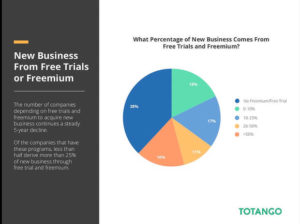
Does this mean that free SaaS trials are useless? Far from it. For a start, this data only discusses brand new customers. Existing customers remain as excited as ever about free trials. They are still eagerly trialing new products and services from their favorite SaaS brands.
Given that existing customers are up to 10 times more likely to convert than even the warmest new lead, this makes free trials more than worth it. By offering existing customers free trials of new or premium products, you can ensure a constant stream of purchases and upgrades.
Even if some existing customers don’t buy into your free trials, offering them is a brilliant customer retention strategy. Your customers will keep coming back to see what’s on offer – and it won’t be long before they sign up!
Can I get brand new customers from free SaaS trials?
While the percentage of new customers gained from free trials has been dropping, the free trial thing is still very much worth doing. On average, brands can gain between 10% and 50% of all new business from free trials. Even at the lower end of the scale, that’s a lot of new business.
Obviously there’s a big difference between 10% and 50%. What makes that difference? Why are some brands gaining so much business through free trials, and others less?
A lot of it depends on how well-established the brand is. There’s a free-trial-conversions bell-curve, which peaks at a level of moderate brand awareness.

Image created by author
For example, software like Microsoft Office suite is already very well known. People don’t feel the need to experience a free trial of Microsoft Office. If they want Word or Powerpoint or Excel or whatever, they skip the trial stage and sign up.
At the other end of the scale are unknown startups. These companies may struggle to get people downloading their software because they’re simply too obscure. People are wary of downloading anything unknown (this is one reason why free trial conversions have dropped in recent years). So, new brands have to work extra-hard to gain trust. Making SaaS security an important part of the offering can help with this.
At the top of the bell-curve are brands well-known enough to be considered trustworthy, but not so well-known that a trial is no longer helpful. People are aware of the brand and they trust its reputation. They may be intrigued about what the brand is offering, but they don’t know enough to decide if it’s what they need. In such circumstances, a free trial is the obvious solution.
If you’re at the startup stage, don’t worry. With some good promotion and clever SEO, you’ll soon hit the top of that bell-curve. How long does it take to see SEO results? Well, with the right tools and a good marketing team, you could find brand awareness rising in a matter of weeks. But even if it takes longer – keep at it! Persistence is key in marketing.
How long should a free SaaS trial last?
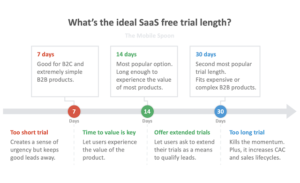
Most trial periods fall into 3 length categories: 7 days or less, 14-30 days, and 30+ days. Which category does your SaaS offering fall into? Well, it depends. This is not the straight answer you were looking for, we know! But bear with us – there’s more.
‘It depends’ on several factors:
- B2B or B2C. As a general rule, B2B SaaS trials are most successful when run between 14 and 30 days.
- Conversion speed. If you need quick conversions, you don’t have time to wait for people to finish their free trial. Be warned that a shorter trial period usually results in fewer conversions – especially if your software is complex or seldom-used.
- Complexity. A free trial is all about people getting used to your product. The more complex the software, the longer this will take. If people need training and/or a long ‘settling-in’ period, the free trial length should account for this. It may be more common for a free trial in your sector to last seven days but if your product is more complex, consider offering users longer to let them really get to grips with it.
- Frequency of use. The more people use something, the more accustomed (and attached) they become to it. If your software is likely to be used less than once a week, extend the trial period. This will ensure that the customer gets enough use out of your software to make an educated decision.
But let’s take a look at the different trial lengths in more detail.
7-Day Trial
This is an ideal length of time if your company is B2C. The price for these services tends to be lower than those aimed at companies and the features tend to be easier to get grips with. So users need a relatively short time to decide if the service is for them.
But with only seven days to convince users of the value of your service it’s important to ensure optimal engagement from the start. This is especially true when 80% of users leave a free trial within two days.
Show the value of your service quickly and effectively by making sure the tutorials and explanations you provide are short and easy to follow. You want users to fall in love with your service from the very first moment.
14-Day Trial
A 14-day trial is great for both B2C and B2B. Consumers have longer to enjoy all the fantastic features you have on offer and there is more pressure on businesses to use your service and make a decision. In fact, many believe that 99% of B2B SaaS companies shouldn’t have a trial longer than this.
With a 14-day trial there is also more flexibility to vary the terms depending on your needs. You can choose to ask for a credit card before the trial starts or not. Maybe you want to give them a 14-day trial which transitions into freemium use. Or perhaps you want to offer a freemium plan with a 14-day trial of your premium service.
While a 14-day trial provides your users with more time to experience your service, it is still important to focus on delivering value rather than bombarding them with upgrade messages. The emphasis needs to be on how beneficial your service is.
30-Day Trial
This is more commonly used for B2B as the extended time period gives users long enough to experience and benefit from your more complex features. You also have longer for your sales and marketing teams to really get to work.
As with a 14-day trial you can choose to request credit card details at different moments, to offer freemium or a trial of your premium service.
If you’re struggling to decide between offering a 14 or 30-day trial, think about the complexity of your software. If you think it’s going to take users longer to really get the most out of the features, a 30-day (or potentially longer) trial could be the better option.
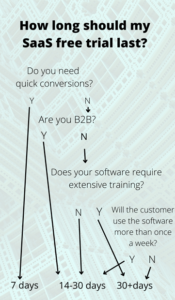
Image created by author
And, after considering all the variables, you’re still not sure, the best thing to do is test. When testing, you’re establishing how long it takes to reach a sweet spot between confidence and boredom. You want people to have used the software long enough to get comfortable with it, but not so long that they get bored with it.
The customer needs to reach a level of confident excitement in your software. The kind that comes from getting to grips with something new and interesting. This point is when you need to catch them with a ‘Trial expiring!’ notice.
Beyond this sweet spot, your software will become mundane and everyday, and there’s a risk that your customer will move on to one of your competitors. Before this sweet spot, your customer will still be working your software out, and won’t feel confident enough in it to invest.
To work out exactly where that sweet spot is, trial your free trial. Offer a free trial of varying lengths, and see which one gets the most conversions.
A good conversion rate of free trial users of a B2B service is between 40-60% but with a little work and experimentation you could get this to 70%. So take the time to really make sure you have the right trial length for you
Free SaaS trials: definitely worth it!
So, how long should your free SaaS trial be? As with everything, it depends on specifications and circumstances. Your brand’s circumstances, your customer’s circumstances, and the specifications of your software.
Most free trials run between 7 and 90 days. Most trials run between 14 and 30 days. However, if your software is particularly complex, or won’t be used enough in 30 days for the user to gain confidence, it’s wise to extend the trial beyond 30 days. At the other end of the scale, if you need fast conversions and/or are extremely confident in your software’s ability to convert, a shorter trial period could be best for you.
A free trial is a fantastic way to draw people into your product. But it’s more than that. It’s also a wonderful lead magnet, a hook to draw engagement, and a great way of building brand awareness. Even if it doesn’t convert, offering a free trial gets you noticed. In this digital age, getting noticed is a rare and valuable thing.
About Author
Jenna Bunnell is the Senior Manager for Content Marketing at Dialpad, an AI-incorporated cloud-hosted unified communications system that provides valuable call details for business owners and sales representatives. She is driven and passionate about communicating a brand’s design sensibility and visualizing how content can be presented in creative and comprehensive ways. Jenna has also written articles for great sites such as CrankWheel and VMblog. Check out her LinkedIn profile.






